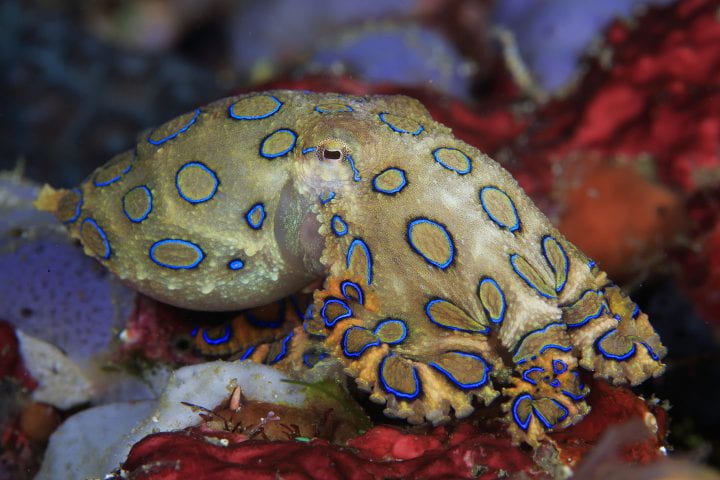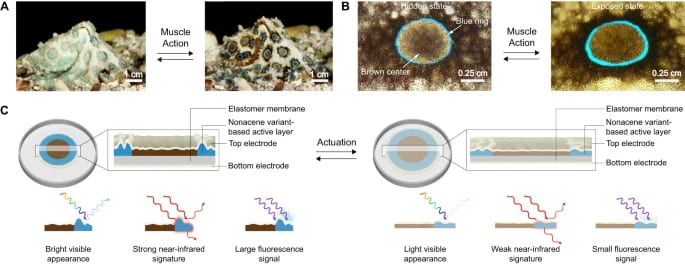UC Irvine engineers invent octopus-inspired technology that can deceive and signal
Unique design approach enables ease of fabrication and self-repair capabilities

Irvine, Calif., Jan 4, 2024 — With a split-second muscle contraction, the greater blue-ringed octopus can change the size and color of the namesake patterns on its skin for purposes of deception, camouflage and signaling. Researchers at the University of California, Irvine have drawn inspiration from this natural wonder to develop a technological platform with similar capabilities for use in a variety of fields, including the military, medicine, robotics and sustainable energy.
According to its inventors, new devices made possible by this innovation will benefit from dynamically adjustable fluorescent and spectroscopic properties, ease of manufacturing, and potential for scaling to areas large enough to cover vehicles, billboards and even buildings. The bio-inspired creation is the subject of a study published recently in Nature Communications.
Hapalochlaena lunulata is a species of octopus native to the Western Pacific Ocean and Indian Ocean. It uses a neurotoxin venom to stun its prey and can ward off predators with a flash of its blue rings. These iridescent circles on a brown background on the creature’s skin are what drew the attention of the UCI researchers.
“We are fascinated by the mechanisms underpinning the blue-ringed octopus’ ability to rapidly switch its skin markings between hidden and exposed states,” said senior co-author Alon Gorodetsky, UCI professor of chemical and biomolecular engineering. “For this project, we worked to mimic the octopus’ natural abilities with devices from unique materials we synthesized in our laboratory, and the result is an octopus-inspired deception and signaling system that is straightforward to fabricate, functions for a long time when operated continuously, and can even repair itself when damaged.”
The architecture of the innovation calls for a thin film consisting of wrinkled blue rings surrounding brown circles – much like those on the octopus – sandwiched between a topmost transparent proton-conducting electrode and an underlying acrylic membrane, with another identical electrode underneath.
Further technical creativity by the researchers occurs at the molecular level as they explored the use of acenes, which are organic compounds made up of linearly fused benzene rings. Designer nonacene-like molecules (with nine linearly fused rings) used by the team help give the platform some of its outstanding capabilities, according to Gorodetsky.
“For our devices, we conceptualized and designed a nonacene-like molecule with a unique architecture,” said co-lead author Preeta Pratakshya, who recently received her Ph.D. in UCI’s Department of Chemistry. “Acenes are organic hydrocarbon molecules with a host of advantageous characteristics, including ease of synthesis, tunable electronic characteristics, and controllable optical properties.”
She added, “Our nonacene-like molecules are exceptional among acenes because they can survive years of storage in air and over a day of continuous irradiation with bright light in air. No other expanded acene displays this combined long-term stability under such harsh conditions.”
According to Gorodetsky, the type of molecules used to fabricate the colored blue ring layer are what endow the devices with their most favorable features, including adjustable spectroscopic properties, the facilitation of straightforward benchtop manufacturing and ambient-atmosphere stability under illumination.
“Our co-author Sahar Sharifzadeh, a Boston University professor of electrical and computer engineering, demonstrated that the stimuli-responsive properties of the molecules can be computationally predicted, which opens paths for the in silico design of other camouflage technologies,” Gorodetsky said.

In their laboratory tests, many of which happened in UCI’s California Institute for Telecommunications and Information Technology, the team found that the bioinspired devices could change their visible appearance over 500 times with little or no degradation, and they also could autonomously self-repair without user intervention.
The invention was demonstrated to possess a desirable combination of capabilities in the ultraviolet, visible light, and near-infrared parts of the electromagnetic spectrum, according to Gorodetsky. This would enable the devices to disguise other objects from detection or to clandestinely signal observers.
“The photophysical robustness and general processability of our nonacene-like molecule – and presumably its variants – opens opportunities for future investigation of these compounds within the context of traditional optoelectronic systems such as light-emitting diodes and solar cells,” added Gorodetsky.
Joining Gorodetsky and Pratakshya in this study were Chengyi Xu, Panyiming Liu, Reina Kurakake, and Robert Lopez in UCI’s Department of Materials Science and Engineering; David Josh Dibble and Anthony Burke in UCI’s Department of Chemical and Biomolecular Engineering; Philip Denison in UCI’s Department of Chemistry; and Aliya Mukazhanova and Sharifzadeh of Boston University. The Office of Naval Research, the Defense Advanced Research Projects Agency, and the National Science Foundation provided funding support.
UCI’s Brilliant Future campaign: Publicly launched on Oct. 4, 2019, the Brilliant Future campaign aims to raise awareness and support for the university. By engaging 75,000 alumni and garnering $2 billion in philanthropic investment, UCI seeks to reach new heights of excellence in student success, health and wellness, research and more. The Henry Samueli School of Engineering plays a vital role in the success of the campaign. Learn more at https://brilliantfuture.uci.edu/the-henry-samueli-school-of-engineering.
About the University of California, Irvine: Founded in 1965, UCI is a member of the prestigious Association of American Universities and is ranked among the nation’s top 10 public universities by U.S. News & World Report. The campus has produced five Nobel laureates and is known for its academic achievement, premier research, innovation and anteater mascot. Led by Chancellor Howard Gillman, UCI has more than 36,000 students and offers 224 degree programs. It’s located in one of the world’s safest and most economically vibrant communities and is Orange County’s second-largest employer, contributing $7 billion annually to the local economy and $8 billion statewide. For more on UCI, visit www.uci.edu.
Media access: Radio programs/stations may, for a fee, use an on-campus ISDN line to interview UCI faculty and experts, subject to availability and university approval. For more UCI news, visit news.uci.edu. Additional resources for journalists may be found at https://news.uci.edu/media-resources/.